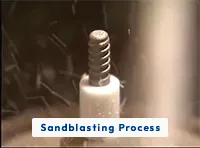About AQB
Types of Implants
Titanium-based implants
●Requires more time for bone attachment
●Lower bone affinity than HA
HA-coated implants
●Higher affinity with bone than titanium
●HA decomposes with heat when coated
●Difficult to create a highly pure and crystalline coating layer
●Easy to dissolve and peel off in vivo
●Fragility is a drawback
disadvantages
AQB Implant

Thin film coating of recrystallized HA
The great thing about recrystallized HA coatings
Hard to peel off
The coating layer is as thin as 35 µm, making it difficult to peel off.
Trace amounts of high-temperature decomposition products
It is almost exclusively a single layer of HA, with almost no high-temperature decomposition products.
Highly crystalline
HA is highly crystalline.
Surface Formation
Needle and hexagonal prismatic HA microcrystals are formed on the surface.
Close to the stoichiometric ratio of pure HA
The Ca/P molar ratio of the coating layer is almost 1.66, close to the stoichiometric ratio of pure HA.
Almost no change in pH of physiological saline
Almost no change in pH of physiological saline.
Low solubility
It has low solubility in vitro (in vitro) and in vivo (in vivo).

Hydroxyapatite 《HA:Ca10(PO4)6(OH)2》is a type of calcium phosphate and a major component of bones and teeth, so it has a high affinity with living tissue and has the property of binding to living bone over time. However, it is difficult to crystallize without high temperature and high pressure, and there is a possibility that HA-coated titanium and titanium alloy implants may leach metallic components when used in the body for a long period of time. In pursuit of sufficient safety, we have developed recrystallized HA-coated implants. AQB implants are made of tricalcium phosphate (TCP: Ca3(PO4)2), which is relatively resistant to degradation at high temperatures and exhibits osteoconductive properties, and coated with a thin film by plasma spraying, followed by hydrothermal treatment to form a recrystallized HA-coated layer (Japanese Patent No. 5891150).
processing process
Hydroxyapatite (HA) coatings have conventionally been produced by plasma spraying HA powder as a thermal spraying material on the surface of a titanium substrate. However, recrystallized HA coating is produced by plasma spraying low-temperature tricalcium phosphate (β-TCP) powder as a thermal spraying material.
Pre-treatment(mirror polishing and sandblasting)
The surface of the titanium substrate is sandblasted and cleaned with acetone.

Plasma spraying


Recrystallized HA coatings are produced by plasma spraying low-temperature stable tricalcium phosphate (β-TCP) powder as a thermal spraying material.
The thermal spray material powder is passed through the plasma flame and sprayed onto the base material, pure titanium. The β-TCP powder comes into contact with the ultra-high temperature plasma flame (10,000°C or higher), melts, and is converted into high-temperature α-TCP, which is then coated onto the titanium surface.
Hydrothermal Treatment
Α-TCP is converted to HA by hydrolysis, and the sprayed implant body is placed in a hydrothermal atmosphere to convert the α-TCP layer to HA (recrystallization).


Coating layer with thermal sprayed HA

The high temperature and rapid cooling process of plasma spraying allows the material to reach the substrate in a decomposed and molten state, resulting in the candy-like vitrification observed in the photograph. Since the decomposition products include CaO, etc., which exhibit strong alkalinity, the crystallinity is low.
Coating layer with recrystallized HA process

Needle-like and hexagonal prismatic crystals characteristic of HA are observed on the surface, indicating the high purity of HA.
experimental data
The difference between HA coating and recrystallized HA coating is obvious in X-ray diffraction!
The preparation of highly crystalline hyaluronan has been considered a difficult technology because of the need to set the spraying conditions such as plasma gas, spraying distance, spraying speed, etc., and the particle size of the raw material powder. In the conventional method using hyaluronan powder as the raw material powder, the coating layer contains impurities with high pH such as tetracalcium phosphate (TeCP) and calcium oxide (CaO) in addition to hyaluronan (see Figure 1). (see Fig. 1). X-ray diffraction of recrystallized HA shows that the crystallinity purity is very high.
Coating layer with thermal sprayed HA




Coating layer with recrystallized HA process



